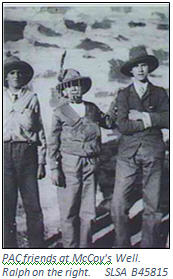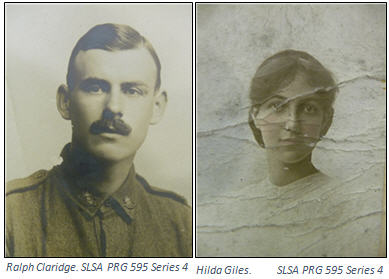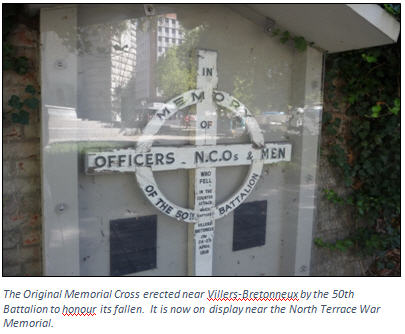Claridge, Lieutenant Ralph Elsmere
Ralph Elsmere Claridge was born on the 11th July 1892. His parents, John Theophilus and Serena Alexandra, (known as Eina), lived in Auburn and Ralph was their only child. 1
Ralph’s short-lived connection with the Campbelltown district began about 1913 when his father John, purchased property on Newton Road Hectorville and established a poultry farm called Brackley.
Ralph’s paternal grandparents, Samuel and Annie Claridge, had immigrated to South Australia in 1854. Samuel initially worked in a drapery business in Rundle Street for 10 years, before moving his family to Auburn where he established a general store and drapery business. Over the next 25 years the business expanded to include stores at Port Pirie, Crystal Brook and Redhill. Ralph’s father, John, had been born in Adelaide and worked with his father at the Auburn store whilst the other stores were managed by John’s brothers. S F Claridge and Sons would have been a well-known name in the mid-north and were highly esteemed for their probity and honourable treatment of their employees. 2
 Samuel, the founder of the S F Claridge and Sons business, died in 1893. In January 1899, John and Eina moved from Auburn to Port Pirie and in June 1900, after a brief stay of 18 months, moved on to Adelaide where they took up residence in Second Avenue East Adelaide. 3
Samuel, the founder of the S F Claridge and Sons business, died in 1893. In January 1899, John and Eina moved from Auburn to Port Pirie and in June 1900, after a brief stay of 18 months, moved on to Adelaide where they took up residence in Second Avenue East Adelaide. 3
Four months after settling in Adelaide with John working as an insurance agent, tragedy struck the family. Eina died suddenly at home after contracting pneumonia. She was only 34 years of age. She was buried in the Payneham Cemetery. 4
By 1902 John and Ralph had moved to Eastry Street Upper Kensington. Ralph attended Marryatville Public School and then Prince Alfred College. A later newspaper article about Ralph suggested he may have also spent some time after school at the School of Mines possibly studying wool classing. 5
About 1906 the family firm, S F Claridge and Sons, purchased a sheep station out of Yunta called McCoy’s Well. Ralph’s father, John, and Uncle George, (who had also moved to Adelaide from Port Pirie,) listed their occupations as sheep farmers or graziers in the Sands and McDougall directories of the time. Ralph enjoyed several visits at least to McCoy’s Well and nearby Ucolta Station. 6
In 1913 when his father John established a poultry farm in Hectorville. It was from here that Ralph enlisted when war was declared in 1914. On the 19th August Ralph completed his enlistment form stating that he lived at the above address and was a poultry farmer. 7
 Ralph was 178cm in height, weighed 73.5kg, had a chest measurement of 100cm and a fresh complexion. He listed that he had experience as a senior cadet at Prince Alfred College. On the same day he made a will which left £50 sterling to Hilda Giles of Unley and the remainder of his estate to his father, John Theophilus Claridge. 8
Ralph was 178cm in height, weighed 73.5kg, had a chest measurement of 100cm and a fresh complexion. He listed that he had experience as a senior cadet at Prince Alfred College. On the same day he made a will which left £50 sterling to Hilda Giles of Unley and the remainder of his estate to his father, John Theophilus Claridge. 8
Ralph was assigned to E Company in the 10th Battalion and left Adelaide on 20th October 1914 on board HMAT Ascanius bound for the European war. 9
When the powers to be, decided to use the Australian forces as part of the Dardanelles campaign, the 3rd Brigade, made up of the 9th, 10th, 11th and 12th battalions, was chosen to be the covering force for the landing at Gallipoli and so Ralph was among the very first Australians to land at Anzac Cove on 25th April 1915. Ralph noted later that he had landed at 4am. After 4 days of fierce fighting to gain the heights and establish a foothold the battalion was relieved from the frontline. They were soon back defending the line when on May 19th the Turkish forces launched a massive attack against the entire Anzac front line with the aim of forcing the Anzacs back to the beach and off the peninsula. When the fighting ceased, the Anzacs were still in their lines, many Turkish soldiers had been killed and Ralph had received a gunshot wound to his right arm. (It was following this battle that a truce was called to enable both sides to bury the dead and assist the wounded.) Ralph was eventually evacuated to the 1st Australian General Hospital in Egypt for treatment. At the end of July, Ralph returned to Gallipoli and served with the 10th Battalion until they were evacuated in late November. Whilst there he was made a Lance-Corporal. 10
Back in Egypt, Ralph was promoted to Corporal and then in February 1916, the 10th Battalion Gallipoli veterans were split and Ralph with many others from the 10th formed the nucleus of a new battalion, the 50th. The new reinforcements were mostly from South Australia so both the 10th and 50th were thought of as South Australian battalions. By April Ralph was a Sergeant and in June the AIF was shipped to France to fight on the Western Front. 11
In August 1916 as part of the Battle of the Somme, the Australian forces, including the 50th Battalion, were involved in the attack and then defence of Pozieres. Under constant heavy artillery barrages the Australian forces suffered huge casualties. Ralph’s battalion was part of the attack on Mouquet Farm just north of the Pozieres town-ship. Ralph recorded in his notebook that of 44 men in his platoon who took part in the attack, 25 became casualties. Ralph was one of them. He again had suffered gunshot wounds to his right arm. This time he was evacuated to the 3rd London General Hospital for treatment. 12
Whilst there he met George J Coates an artist who persuaded Ralph to sit for a painting. The painting was titled, “For the Empire, (a wounded Anzac.)” It was hung in the Royal Academy Exhibition in 1917 and published in the Royal Academy Illustrated of the same year. It received favourable reviews and was reported on in South Australian newspapers. 13
Once discharged Ralph spent time on leave and also spent several months at the No. 3 School of Instruction for Infantry Officers at Tidworth. His Certificate of Attendance rated his efforts as “Very Good” and he achieved second highest marks with 81%. 14
In July 1917 he was made a Second Lieutenant and spent several months with the Overseas Training Brigade before rejoining the 50th in France in February 1918 where he was promoted in the field to Lieutenant. 15
Early in April of 1918, near Dernancourt the 50th Battalion as part of the 13th Brigade assisted in repulsing the largest German attack on Australian troops during the war. On the 23rd April the German forces captured the village of Villers-Bretonneux. On the night of 24th-25th April the Australian forces including Ralph’s 50th Battalion went on the offensive and in heavy fighting recaptured the town from the Germans. 16
 It was during this action that Ralph was firstly reported as missing and then confirmed dead by machine-gun fire on the 25th April 1918. It was 3 years to the day since Ralph had first set foot on Gallipoli. Soldiers from the 49th Battalion had found Ralph’s body and buried him in the field and returned what effects he had with him to the 50th Battalion. 17
It was during this action that Ralph was firstly reported as missing and then confirmed dead by machine-gun fire on the 25th April 1918. It was 3 years to the day since Ralph had first set foot on Gallipoli. Soldiers from the 49th Battalion had found Ralph’s body and buried him in the field and returned what effects he had with him to the 50th Battalion. 17
Ralph’s gravesite was unable to be located and so he is commemorated at the Villers-Bretonneux Australian Memorial along with approximately 10,000 other missing soldiers. 18
Ralph’s father, John, and fiancée, Hilda, must have been heartbroken at his loss.
Later in 1918 Ralph’s will was finalised and in the will, Hilda Giles was identified as Ralph’s fiancée and his occupation was given as wool classer.
John sold the Brackley poultry farm about 1918 and moved back to living with his brother George and sister-in-law, Lilla, at 2 Wakefield Street Kent Town. Lilla died in 1922 and George and John then lived at 20 Edwin Street Gilberton. George passed away in April of 1931 aged 78 and a month later John died aged 72. John had been a member of the Oddfellows Lodge for 50 years and was a life member. He also played lawn bowls and was a member at the Walkerville Club. John and George must have been very close after spending so much of their lives together. 19
Hilda corresponded with George Coates the artist, who agreed to sell the painting to Hilda for £30. Hilda with assistance from relatives and friends managed to get the painting shipped to South Australia. At some point she had a well-known artist, Will Ashton, make some alterations to the bandaged hand. In a letter to her nephew in 1953 Hilda wrote, “Sometimes I have wondered whether I was wise in permitting that but tis too late to dwell on that now.”
The painting was lent to the Art Gallery of South Australia until 1924 and it was then lent to the Trustees of the Memorial Hospital where it stayed until 1967.
Hilda married Walter Dellow on the 26 December 1921 and moved to N.S.W. In 1953-54 she had concerns about the future ownership of the painting. Her wish was that the painting remain in the family so that a personal interest was taken for another generation at least. Possibly not having children of her own, she asked a nephew living in South Australia if he would accept ownership, which he did. From 1967 the painting hung in his home until his death in 1984 when his daughter offered the painting and other items related to Ralph Claridge to the Mortlock Library. The painting is being held on indefinite loan with the ownership passing to the Libraries Board on the death of the daughter. 20
Walter Dellow died in 1962 and Hilda in 1974. 21
And now nearly 100 years after Ralph’s portrait was painted I believe Hilda would be pleased to know that there are still people interested in the painting and Ralph’s story.
Amongst Ralph’s effects was a 1915 Christmas card containing messages from the Gallipoli commanders. The much maligned overall commander, General Sir Ian Hamilton, did get one thing right in his handwritten message to the Australians at Christmas 1915 when he wrote,
“Happen what may the Australians who have fought at Gallipoli will bequeath a heritage of honour to their children’s children.” 22
Researched and compiled by Geoff Burton, a volunteer with the Campbelltown Library “Digital Diggers” group.
If you have any comments or questions regarding the information in this local history article, please contact the Local History officer on 8366 9357 or hthiselton@campbelltown.sa.gov.au
References
- 1892 'Family Notices.', South Australian Chronicle (Adelaide, SA : 1889 - 1895), 16 July, p. 4, viewed 19 May, 2015, http://nla.gov.au/nla.news-article92294649
- 1893 'WORK FOR THE UNEMPLOYED.', South Australian Register (Adelaide, SA : 1839 - 1900), 24 June, p. 4, viewed 19 May, 2015, http://nla.gov.au/nla.news-article48528730
- 1899 'FAREWELL SOCIAL.', Chronicle (Adelaide, SA : 1895 - 1954), 28 January, p. 18, viewed 19 May, 2015, http://nla.gov.au/nla.news-article87784167
- 1900 'Family Notices.', South Australian Register (Adelaide, SA : 1839 - 1900), 30 October, p. 4, viewed 19 May, 2015, http://nla.gov.au/nla.news-article54538381
- 1918 'THE AUSTRALIANS.', The Register (Adelaide, SA : 1901 - 1929), 14 May, p. 6, viewed 19 May, 2015, http://nla.gov.au/nla.news-article60358157 (see also: Sands and McDougall Directory 1902 p153.)
- 1906 'McCOY'S WELL AND UCOLTA.', The Register (Adelaide, SA : 1901 - 1929), 20 July, p. 4, viewed 19 May, 2015, http://nla.gov.au/nla.news-article57017482
- 1914 'THE POULTRY INDUSTRY.', Chronicle (Adelaide, SA : 1895 - 1954), 31 January, p. 13, viewed 19 May, 2015, http://nla.gov.au/nla.news-article88831911 (See also: National Archives of Australia, NAA Series Number B2455, Barcode 3250552, Claridge Ralph Elesmere, p1.)
- National Archives of Australia, NAA Series Number B2455, Barcode 3250552, Claridge Ralph Elesmere, p3 and 16.
- National Archives of Australia, NAA Series Number B2455, Barcode 3250552, Claridge Ralph Elesmere, p4.
- Gallipoli by Les Carlyon. Chapters 10, 15. National Archives p8.
- National Archives of Australia, NAA Series Number B2455, Barcode 3250552, Claridge Ralph Elesmere, p4.
- The Great War by Les Carlyon. Chapter 12. National Archives p11. State Library of South Australia PRG 595, Series 4.
- 1917 'SOUTH AUSTRALIAN SOLDIER PAINTED.', The Register (Adelaide, SA : 1901 - 1929), 8 September, p. 8, viewed 19 May, 2015, http://nla.gov.au/nla.news-article60328030 See also 1918 'CONCERNING PEOPLE.', The Register (Adelaide, SA : 1901 - 1929), 26 June, p. 6, viewed 19 May, 2015, http://nla.gov.au/nla.news-article60361779. SLSA PRG 595, Series 4.
- National Archives of Australia, NAA Series Number B2455, Barcode 3250552, Claridge Ralph Elesmere, p19.
- National Archives of Australia, NAA Series Number B2455, Barcode 3250552, Claridge Ralph Elesmere, p20.
- Carlyon, Les, 2010, The Great War, Chapter 40.
- National Archives of Australia, NAA Series Number B2455, Barcode 3250552, Claridge Ralph Elesmere, p20 and 27.
- 'Commonwealth War Graves Commission - Casualty Details'. 2015. Web. viewed 19 May, 2015 https://www.cwgc.org/find-records/find-war-dead/casualty-details/1459136/ralph-elsmere-claridge/
- 1931 'Late Mr. J. T. Claridge.', News (Adelaide, SA : 1923 - 1954), 29 May, p. 6 Edition: HOME EDITION, viewed 19 May, 2015, http://nla.gov.au/nla.news-article129043343
- SLSA PRG 595, Series 3.
- Sydney Morning Herald 20/8/1962. Sydney Morning Herald 27/5/1974.
- SLSA PRG 595, Series 6.
